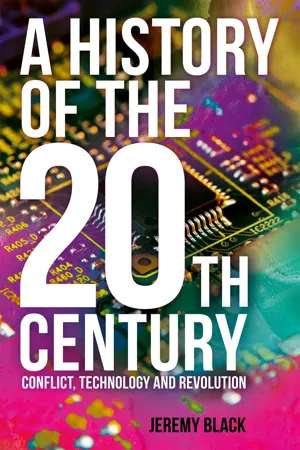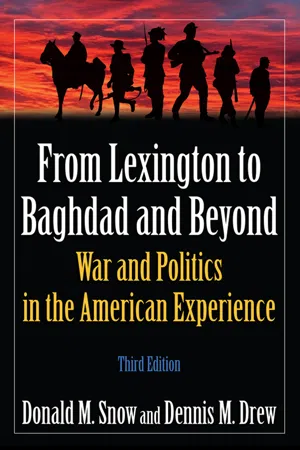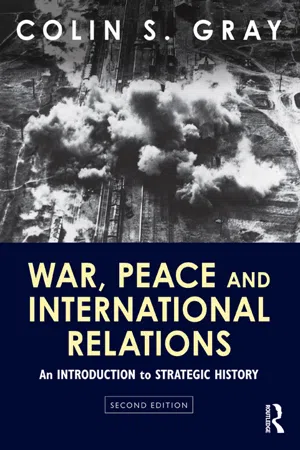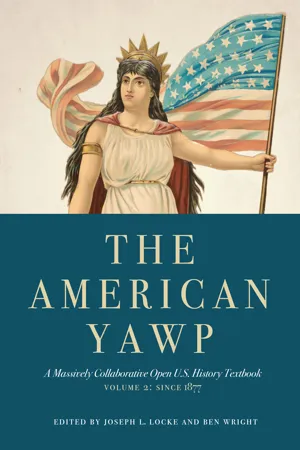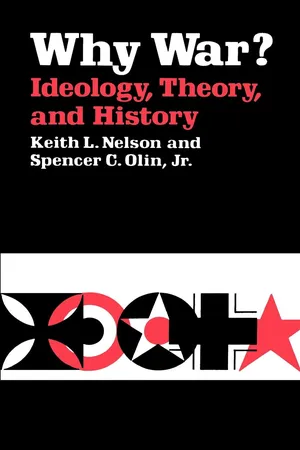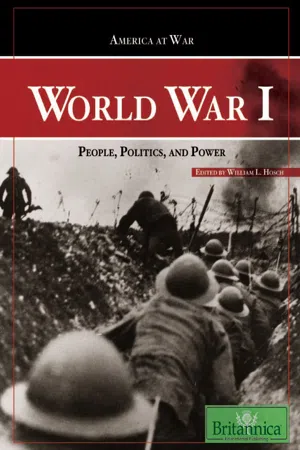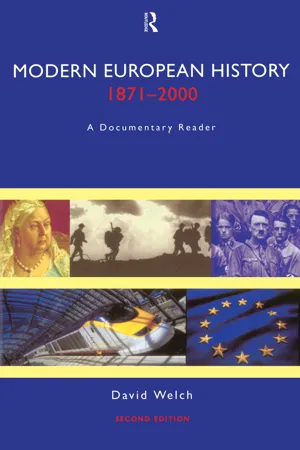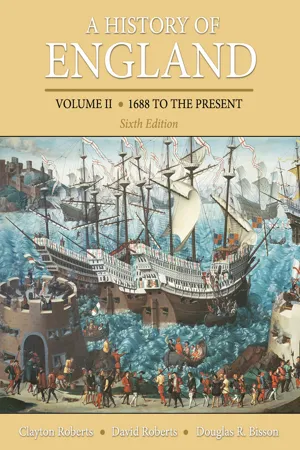History
WWI
WWI, or World War I, was a global conflict that lasted from 1914 to 1918. It involved many of the world's great powers and their alliances, and was primarily centered in Europe. The war had a profound impact on the political, social, and economic landscape of the 20th century, leading to significant changes in international relations and the emergence of new nations.
Written by Perlego with AI-assistance
Related key terms
12 Key excerpts on "WWI"
- eBook - ePub
A History of the 20th Century
Conflict, Technology and Revolution
- Jeremy Black(Author)
- 2022(Publication Date)
- Arcturus(Publisher)
Chapter 2
World War I, 1914–1918
A conflict of unprecedented scale and range, World War I was a traumatic military struggle that transformed the countries involved and the world as a whole. The war had major political, social, economic and cultural consequences for all the leading participants. Russia changed dramatically through the Bolshevik revolution, while a deadly new disease swept across the world just as the war was coming to an end.The Great War
The occasion of the war was the assassination of Franz Ferdinand, the heir to the Austro-Hungarian empire, by Serbian terrorists in Sarajevo, the capital of Bosnia. While Austria was understandably outraged by the attack, it also gave the country the useful pretext it needed to provoke what it thought would be a small conflict in the Balkans to check Serbia’s growing influence in the region. The Austrians presented Serbia with a list of ten extremely harsh demands to resolve the crisis that they knew would be rejected, enabling them to declare war. What Austria did not know was that Serbia’s ally Russia had promised to support it in any conflict, come what may. And what Russia did not know was that Germany had made exactly the same promise to its ally, Austria.When Austria declared war on Serbia on 28 July 1914 it brought into play a complicated system of alliances. Germany, discovering it was now obliged to go to war with Russia, made a strategic decision to first launch a surprise attack on that country’s other ally, France, to avoid having to engage in battles on two fronts. In 1905 Germany had developed a strategy for precisely this purpose. It was called the Schlieffen Plan and it meant that to take Paris Germany first had to invade Belgium.The Western Front
The German invasion of Belgium in 1914 brought Britain into the war. This may not have unduly worried Germany. Britain at that time was largely a naval power and had not fought another major power on the European mainland since the Crimean War with Russia in 1854–6. But Germany’s hopes of delivering a quick knockout blow to France was thwarted by a successful Allied counterattack in the Battle of the Marne in September 1914. This was followed by the failure by both sides to outflank each other in the ‘Race to the Sea’, resulting in a stalemate as the Allies and the Germans became bogged down along a front that embraced eastern France and a portion of Belgium. To protect the troops from the deadly ravages of rapid-fire artillery, both sides dug in. This was the beginning of what became known as trench warfare. - eBook - ePub
- Heikki Patomäki(Author)
- 2007(Publication Date)
- Routledge(Publisher)
4 The origins of the First World War Using historical counterfactuals in constructing open-system explanationsWhat explains the 1914–18 war that claimed the lives of 10 million people, caused unprecedented levels of social and industrial mobilisation and triggered some of the most remarkable military and, subsequently, political revolutions? There are thousands of scholarly and popular works on the Great War. However, many well-known historical accounts of the First World War contextualise the war only briefly before moving to discussing in detail its outbreak, escalation, strategies, battles, negotiations and outcomes (e.g. Stevenson 2004); or tend to focus on the armaments race of the last decade before the war (e.g. Stevenson 1996). However, there have also been longerterm historical accounts, such as A.J.P. Taylor’s (1971) standard benchmark treatise The Struggle for Mastery in Europe, 1848–1918 ; Joachim Remak’s (1976) The Origins of World War I, 1871–1914 ; and Eric Hobsbawm’s (1994a) repeatedly reprinted The Age of Empire, 1875–1914 , focusing on the war in the last chapter.1The academic discipline of International Relations (IR) was founded in 1919 in response to the Great War. As a social science, IR has been expected to search for generalisable theories and causal accounts. Its original task was to find out the causes of war in order to prevent the catastrophe of 1914–18 from ever being repeated. The catastrophe was soon repeated – or, in an important sense, continued – in the form of the Second World War. Before long, in the cold war context, the First World War lost its special importance for IR. For instance, both Neorealist (Waltz 1979:172; Gilpin 1981:145, 192–94, 200–7) and neo-Marxist (Wallerstein 2000:258) theories of hegemonic stability and succession present the outbreak of the First World War as a mere instance of theory-derived and simple law-like regularities in world politics. These studies do not compare different explanatory stories or assess critically the available empirical evidence about trends and episodes that led to the outbreak of the war. Even the more open-minded empirical studies of war and peace (e.g. Vasquez 1999:268–69, 272–74) have characteristically discussed the origins of the First World War only as an empirical case of one war among numerous wars. A notable exception to this tendency to neglect concrete analysis of the causes of the First World War has been the lateral pressure theory. This was developed by Nazli Choucri and Robert C. North (1975) to synthesise historical narratives of the long-term developments that led to the 1914–18 war and, simultaneously, test quantified hypotheses against the available data. With the exception of the lateral pressure theory and a few notable articles (e.g. Lebow 2000; 2001), and with a partial exception of works such as Richard Hamilton and Holger Herwig’s (2003) The Origins of World War I - eBook - ePub
From Lexington to Baghdad and Beyond
War and Politics in the American Experience
- Donald M Snow, Dennis M. Drew(Authors)
- 2015(Publication Date)
- Routledge(Publisher)
4WORLD WAR IThey called it the Great War. For many it was the “war fought to end all wars” and, for the United States, it became a war “to make the world safe for democracy.” Battle after battle, campaign after campaign, and year after year passed inconclusively amid unprecedented carnage, suffering, and destruction. It was the largest, bloodiest war in human history to that time. Literally millions were mobilized to fight it, and millions died in the no man’s land between the opposing trenches that scarred the Western Front in virtually unbroken lines from the Alps to the North Sea. According to demographers, France would need 66 years merely to recoup the young men who died during the war. The war’s bloodiest battle claimed 650,000 lives and when it was over, the lines had scarcely moved. That outcome symbolized the futility of the fighting generally and helped create an enormous cynicism in those ordered to fight and die for no apparent reason or effect.World War I changed the face of Europe and the face of war. The decline of Europe as the center of Western civilization began during this time and would be completed 20 years later in the second world conflagration. The once dominant countries of Europe bled themselves dry of manpower and treasure and thereby lost the physical wherewithal to control international politics after 1945. Militarily, the Great War carried the logic of total war previewed in the American Civil War forward toward its grisly fulfillment in World War II.Although the United States was eventually drawn into the awful fray, it was not really an American war. Certainly the issues that gave birth to the war were, at most, peripheral to American concerns. Moreover, the United States entered the fighting at an extremely late date. Our contribution to pushing an exhausted Germany over the brink to defeat, while psychologically important, was minor compared to the effort of the other combatants. - eBook - ePub
War, Peace and International Relations
An introduction to strategic history
- Colin S. Gray(Author)
- 2013(Publication Date)
- Routledge(Publisher)
6 World War I, I
ControversiesReader's guide: Controversies about World War I. The scale of the conflict. Casualties.Introduction: the making of the twentieth century
With black humour, one could argue that the Great War of 1914–18 was the kind of conflict that gives war a bad name. War should be an instrument of policy; Clausewitz is crystal clear on that fundamental. However, once the basic decisions to fight were taken, for four and a quarter years warfare seemed more in command of the policies of states than commanded by them. That was not quite true, but nor was it wholly an illusion. The strategic historian takes serious note of Gary Sheffield's expansive claim that ‘The First World War was the key event of the twentieth century, from which everything else flowed’ (Sheffield, 2001: 221). Sheffield is persuasive, provided one does not take too literally his assertion that ‘everything else flowed’ from the war. One has to beware of such a vague concept as the flow of events – sometimes events seem to trickle lazily, at other times they appear to rest, while they have also been known to reverse direction as in ‘a turning tide’. While there is no doubt that in many vital respects the Great War made the twentieth century, certainly politically and strategically, there is good reason to question the responsibility of the war for all that followed over the next eighty years.It is plausible to claim that the Great War against France which concluded in 1815 had reshaped, even redefined, international politics for at least a half-century. Similarly, it is scarcely less persuasive to argue that Bismarck's wars to unite Germany under Prussian tutelage and for Prussia's benefit reconstructed the architecture of the balance of power. The German Chancellor decisively altered the way that international politics would have to be managed by the great powers. Now the temporal domain of the strategic historical argument needs to be extended. The war of 1914–18 was uniquely responsible for setting the stage for, and thereby enabling, the major political and strategic events of the century that followed, but even the most influential of historical episodes, which tend to be strategic in character, do not drive forward along predetermined linear paths. Two fallacies beg for attention. - eBook - ePub
The American Yawp
A Massively Collaborative Open U.S. History Textbook, Vol. 2: Since 1877
- Joseph L. Locke, Ben Wright(Authors)
- 2019(Publication Date)
- Stanford University Press(Publisher)
21 World War I and Its AftermathStriking steel mill workers holding bulletins in Chicago, Illinois, on September 22, 1919. ExplorePAhistory.com.I. IntroductionWorld War I (“The Great War”) toppled empires, created new nations, and sparked tensions that would explode across future years. On the battlefield, gruesome modern weaponry wrecked an entire generation of young men. The United States entered the conflict in 1917 and was never again the same. The war heralded to the world the United States’ potential as a global military power, and, domestically, it advanced but then beat back American progressivism by unleashing vicious waves of repression. The war simultaneously stoked national pride and fueled disenchantments that burst Progressive Era hopes for the modern world. And it laid the groundwork for a global depression, a second world war, and an entire history of national, religious, and cultural conflict around the globe.II. Prelude to WarAs the German empire rose in power and influence at the end of the nineteenth century, skilled diplomats maneuvered this disruption of traditional powers and influences into several decades of European peace. In Germany, however, a new ambitious monarch would overshadow years of tactful diplomacy. Wilhelm II rose to the German throne in 1888. He admired the British Empire of his grandmother, Queen Victoria, and envied the Royal Navy of Great Britain so much that he attempted to build a rival German navy and plant colonies around the globe. The British viewed the prospect of a German navy as a strategic threat, but, jealous of what he perceived as a lack of prestige in the world, Wilhelm II pressed Germany’s case for access to colonies and symbols of status suitable for a world power. Wilhelm’s maneuvers and Germany’s rise spawned a new system of alliances as rival nations warily watched Germany’s expansion. - eBook - ePub
The Global Economy
A Concise History
- Franco Amatori, Andrea Colli, Franco Amatori, Andrea Colli(Authors)
- 2019(Publication Date)
- Routledge(Publisher)
THE GREAT WAR: THE END OF A WORLDSUMMARY : 10.1. Interpretation of the war: discontinuity and social revolution. – 10.2. Total war: industrial planning and mobilization. – 10.3. The geopolitical and economic consequences . – Bibliography.10.1. Interpretation of the war: discontinuity and social revolution
The First World War ended a period of peace and progress that had lasted almost uninterrupted since 1870. The conflict weakened Europe, which lost its political and economic supremacy for good, and it also shaped world geopolitics until 1989. International trade was seriously damaged, and the international monetary system ceased regulating the relations between currencies.The First World War was defined as “great” not just because of the numbers of countries or troops involved, the scale of destruction and death it caused or the duration of the conflict itself, but also because it was revolutionary and levelling, cutting across all social classes. It was a kind of incubator for the transformations that were to occur in the 20th century. The war modified politics, society, culture and the economy, marking the end of positivism and liberal individualism. It led to the development of a new collectivist concept of the state, which guaranteed new rights for its citizens, redefining and reshaping the relations between political power and capitalism. The state broadened its prerogatives of intervention, vigilance and control, not only in economic affairs but also in social issues. In the period between the two wars, the state also implemented population and public health policies, entering into the most private spheres of individual and family life to compensate for the generation gap caused by the loss of so many young people in war.The 1919 constitution of the Weimar Republic was written immediately after Germany’s defeat, and was an ideal representation of the classless society born in the trenches. It was the archetype of an original conception of the national community, providing an ideal model for the new 20th century democracies. It enshrined a new concept of the citizen-state relationship, making the state responsible for satisfying citizens’ essential needs (work, education and health). It redesigned the connections between collective and individual rights and exalted the dignity of intellectual and manual work. It revolutionised the relations between capital and labour, income and profit, income and labour, to the benefit of the community. - eBook - ePub
- John Mueller(Author)
- 2013(Publication Date)
- Cornell University Press(Publisher)
CHAPTER 3
WORLD WAR I AS A WATERSHED EVENT
European attitudes toward war changed profoundly at the time of World War I. There is no way to quantify this change except perhaps through a rough sort of content analysis. Before the First World War it was very easy, as documented in the previous chapter, to find serious writers, analysts, and politicians in Europe and the United States exalting war as desirable, inevitable, natural, progressive, and necessary. After the First World War, such pronouncements become extremely rare, although the excitement of the combat experience continued (and continues) to have its fascination to some.1This suggests that the appeal of war, both as a desirable exercise in itself and as a sensible method for resolving international disagreements, diminished markedly on that once war-racked continent. In an area in which war had been accepted as a standard and permanent fixture, the idea suddenly gained substantial currency that war there was no longer an inevitable or necessary fact of life and that major efforts should be made to abandon it.This change has often been noted by historians and political scientists. Arnold Toynbee points out that World War I marked the end of a “span of five thousand years during which war had been one of mankind’s master institutions.” In his study of wars since 1400, Evan Luard observes that “the First World War transformed traditional attitudes toward war. For the first time there was an almost universal sense that the deliberate launching of a war could now no longer be justified.” Bernard Brodie points out that “a basic historical change had taken place in the attitudes of the European (and American) peoples toward war.” Eric Hobsbawm concludes that “in 1914 the peoples of Europe, for however brief a moment, went lightheartedly to slaughter and to be slaughtered. After the First World War they never did so again.” And K. J. Holsti observes, “When it was all over, few remained to be convinced that such a war must never happen again.”2 - eBook - ePub
- Keith L. Nelson, Spencer C. Olin(Authors)
- 2023(Publication Date)
- University of California Press(Publisher)
CHAPTER FOUR Historians and World War ITHE EXISTING INTERPRETIVE FRAMEWORKIn order to demonstrate the usefulness of the categorizations we have devised for analyzing studies of war, it is necessary for us to relate them to a significant number of interpretations of a significant number of major conflicts. Only in this way can we show that, in fact, (1) ideology does influence theory, (2) historians do have ideologies as well as theories which correspond to our major ideal types but about which they are not always conscious or consistent, and (3) we can better understand, compare, and evaluate what historians are saying when we comprehend their ideological and theoretical perspectives. We can also cast new light on longstanding historiographical controversies, revealing to what extent their noise and thunder may disguise basic agreements or disagreements about assumptions or crucial data.To accomplish our objective we have chosen to examine writings about two great twentieth-century conflicts: World War I and World War II. We have selected these conflicts not on any random basis but because they are obviously important, complex, and well documented. They also have in common certain social, political, and technological characteristics (for example, that their belligerents possessed such constituent elements as cities, political parties, and sophisticated communications media) the absence of which might make comparisons of their histories much more difficult. We do believe, however, that the categories we offer can be utilized to assist in mastering the historiography of any war or comparable phenomenon (see the Epilogue).To set the scene for scrutinizing the several interpretations of World War I we must briefly trace the course of the historical debate about that subject. This will enable the reader to put each of the historians and his commentary within an essentially familiar context. It will also allow one to compare and contrast the traditional view of the writing in question with our own. - eBook - ePub
World War I
People, Politics, and Power
- Britannica Educational Publishing, William Hosch(Authors)
- 2009(Publication Date)
- Britannica Educational Publishing(Publisher)
CHAPTER 1 THE ROOTS OF WORLD WAR IA fter forty-three years of peace among the Great Powers of Europe, an act of political terrorism on June 28, 1914 provoked two great alliance systems into mortal combat. The South Slav campaign against Austrian rule in Bosnia, culminating in the assassination of Archduke Francis Ferdinand—the Habsburg heir apparent—at Sarajevo, catalyzed a rapid chain reaction leading to War. This local crisis quickly engulfed all the powers of Europe through the mechanisms of the Triple Alliance and the Triple Entente, diplomatic arrangements meant precisely to enhance the security of their members and to deter potential aggressors. The long-term causes of the war can therefore be traced to the factors that impelled the formation of those alliances, increased tensions among the Great Powers, and made at least some European leaders desperate enough to seek their objectives even at the risk of a general war. These factors include the forces of militarism and mass mobilization, instability in domestic and international politics occasioned by rapid industrial growth, global imperialism, popular nationalism, and the rise of a social Darwinist world-view. However, the question of why World War I broke out should be considered together with two further questions: why did this period of peace between the Great Powers of Europe finally end, and why did it end in 1914 rather than before or after?A portrait of Otto Eduard Leopold von Bismarck, the first chancellor of the German Empire, c. 1880. Hulton Archive/Getty ImagesINDUSTRIALISM AND IMPERIALISM
PATTERNS OF POPULATION
In the 19th century, both demographic and industrial growth in Europe were frantic and uneven, with both qualities contributing to growing misperceptions and paranoia in international affairs. The European population grew at the rate of 1 percent per year in the century following 1815, an increase that would have been disastrous had it not been for the outlet of emigration and the new prospects of employment in the rapidly expanding cities. However, as the distribution of Europe’s peoples changed radically, the military balance among the Great Powers also shifted. In the days of Louis XIV, France was the wealthiest and most populous kingdom in Europe, numbering 25,000,000 to Britain’s 14,500,000 as late as 1789. When the French Revolution unleashed this national power through rationalized central administration, meritocracy, and a national draft predicated on patriotism, it achieved unprecedented organization of force in the form of armies of millions of men. - eBook - ePub
American Stories
Living American History: v. 2: From 1865
- Jason Ripper(Author)
- 2015(Publication Date)
- Routledge(Publisher)
6World War I
Trench aid. (Sergeant Leon H. Caverly/Getty Images)Did Civilization Civilize?
What has been known since the 1940s as World War I, but which was roundly known at the time as the Great War, made the days of the early 1900s seem like a drowned dream peopled with fairy children waving from an innocent place lost in time. Theodore Roosevelt’s own children, giddily known as the White House Gang, once planned an “attack” on the White House. President Roosevelt caught wind of their invasion scheme and sent them a note through the War Department telling them to abort the attack. Within ten years of Roosevelt’s leaving the White House, the War Department was sending messages about a genuine call to arms after hostilities broke out in Europe in 1914.While war had always been what William Tecumseh Sherman plainly called “hell,” the Great War leeched away age-old romantic fantasies about “good” wars. The romance was poisoned on battlefields where chemical gas attacks caused men’s lungs to bleed and their skin to pucker, boil, and sometimes burn down to the bare bleached bone. Young soldiers frightened by wafting green clouds of chlorine gas choked down their fear and struggled to fit gas masks over their horse’s heads. The old world and the new crashed into each other on the bomb-pitted Western Front of France and Belgium as wooden reconnaissance airplanes whirred over baggage trains of rickety wagons pulled by mules andhorses. From 1914 through 1918, at least 10 million men died on the battlefields of Europe, including 115,000 U.S. soldiers—“doughboys”—who began arriving in mid-1917. France and Germany buried roughly 16 percent of their male populations, almost one out of every five men. - eBook - ePub
Modern European History, 1871-2000
A Documentary Reader
- David Welch(Author)
- 2020(Publication Date)
- Routledge(Publisher)
July 1914. The Long Debate, 1918—1990 (1991).There is also a vast literature on the general history of the war: A.J.P. Taylor, The First World War: An Illustrated History (1966) – a moving photographic record of the conflict; B.H. Liddell-Hart, History of the First World War (1970). M. Ferro, The Great War (1963) is a short but brilliant introduction. See also J. Terraine, The Western Front, 1914–18 (1964). For works which place the military aspects of the war in a broader context see K. Robbins, The First World War (Oxford, 1984); B. Bond, War and Society in Europe, 1870–1970 (1984); G. Hardach, The First World War (1977); and more recently J. Keegan, The First World War (1998). The fateful first days of the conflict are evocatively captured in R. Wohl, The Generation of 1914 (1979) and B. Tuchman, August 1914. The First Month of the First World War (1994).The nature of ‘total war’ and the impact of technology is discussed in E. Kehr, Economic Interests, Militarism and Foreign Policy (1977); G. Krumeich, Armaments and Politics in France on the Eve of the First World War (1984); J. Ellis, Eye-Deep in Hell (1976); A.E. Ashworth, The Trench Warfare (1980); E. Leeds, No Man’s Land (1979); while A. Horne, The Price of Glory: Verdun, 1916 (1964); L. Macdonald, They Called it Passchendaele (1983); M. Middlebrook, The First Day on the Somme (1971) and The Kaiser’s Battle (1983) (on Germany’s 1918 offensive) give full treatment of individual battles, as doesj. Keegan, The Face of Battle (1979).The impact of the war on individual societies can be found in D. Welch, German Society, Propaganda and Total War, 1914–18: The Sins of Omission (1999); J. Kocka, Facing Total War: German Society, 1914–1918 (1985); A. Rosenberg, Imperial Germany: The Birth of the German Republic (1931); A. Marwick, The Deluge: British Society and the First World War (1965); J. Winter, The Great War and the British People (1985); B. Waites, A Class Society at War, England 1914–1918 - eBook - ePub
A History of England, Volume 2
1688 to the present
- Clayton Roberts, David Roberts, Douglas Bisson(Authors)
- 2016(Publication Date)
- Routledge(Publisher)
HAPTER 27BRITAIN AND WORLD WAR IChapter Outline
■ Why England Went to War■ A Confusion of Strategies: 1914-1915■ The Home Front■ Working for the War■ The Western Front: 1916-1918■ The Coupon Election and the Peace of Versailles■ The Irish War of Independence: 1916-1921THREE QUARTERS OF A MILLION BRITISH SOLDIERS died in World War I. Nearly 2 million more were wounded, hundreds of thousands hopelessly maimed and disfigured. Many suffered war's newest curse, shell shock, and spent years in mental hospitals. Shock of all kinds lodged itself in the memories of frontline soldiers, the shock of the most horrible of wars, of muddy trenches, murderous shell fire, the constant fear of death, the tediousness of endless watches, the stupidity of blundering attacks, and the overwhelming sense of the war's futility.The home front also experienced shock. German zeppelins and airplanes killed 1413, wounded more, and destroyed buildings. German submarines sank British ships so rapidly that they threatened to shut off Britain's food and raw materials. Rationing and conscription and a war socialism were adopted. Total war had engulfed the British for the first time.Total war and the unparalleled horrors at the front also sent shock waves through the most deeply rooted of British beliefs and institutions. Progress no longer seemed inevitable. Human nature was not, after all, rational and good, but, as the Viennese psychoanalyst Sigmund Freud had written, irrational and neurotic. The religion of the Prince of Peace became a mockery as German ecclesiastics blessed the war. Civilization and decency seemed cast aside, while morality became the handmaid of propagandists. All was changing. Women were no longer housewives but ran lathes at munition factories, won the vote, and smoked cigarettes. Workers formed stronger unions and demanded a greater share of income. New ideas and new groups acted as a dissolvent in these four years of bewildering events. No other four years of British history can compare with these, either in terms of sheer suffering and tragedy or of the shattering impact on the nations beliefs. It was the most traumatic event the British had ever experienced. It closed the door on the secure nineteenth century and opened the way to the uncertainties of the twentieth. Its very importance prompts the question of why Britain became involved in such a holocaust.
Index pages curate the most relevant extracts from our library of academic textbooks. They’ve been created using an in-house natural language model (NLM), each adding context and meaning to key research topics.
